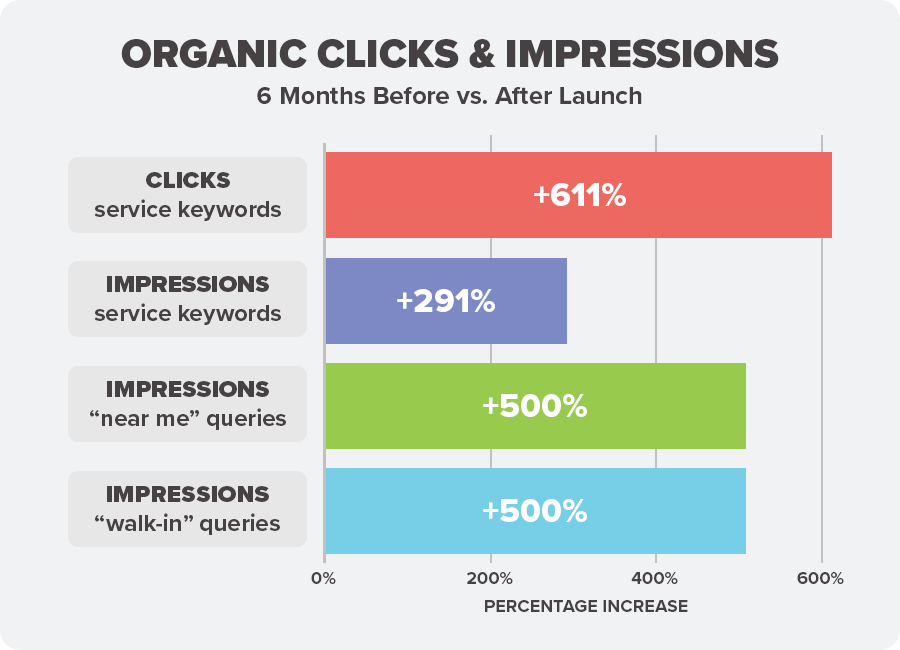Challenge: Lack of Visibility for Medical Services
A multi-location urgent care in Omaha was wanting to get more patients in the door. Our SEO team ran a website audit, where we learned the client lacked dedicated pages for several highly-searched urgent care services, causing them to lose patients to competitors who were showing up in relevant organic and local search results.
Solution: Built Landing Pages for Core Services
To improve visibility in SERPs and reach patients ready to walk in or schedule an appointment, we built landing pages around high-intent urgent care services with local relevance.
Step One: Identified Additional Service Page Opportunities
- Audited the client’s existing site to see which services already had pages
- Identified content gaps where search demand and business goals aligned, like sports physicals, X-rays, and drug testing
- Prioritized services based on local search interest and conversion potential
Hurrdat’s SEO Manager, Molly Q., explains why it was important for each service to get a dedicated page:
“For YMYL websites—especially in healthcare—you need to demonstrate trust, expertise, and authority across every page. By creating a strategy around individual service pages, we were able to provide specific, helpful, and accurate information that addressed patient concerns directly. It wasn’t just about improving SEO performance—it’s about building a trustworthy experience for both users and search engines. This approach is core to E-E-A-T and essential for clinics looking to compete in organic and local search.”
Step Two: Researched SERPs & Competitors
- Reviewed competitive SERPs to see which businesses appeared in both the local pack and organic rankings
- Identified which competitor service pages were ranking and assessed their structure, tone, and content depth
- Analyzed the types of questions competitors were answering, the keywords they were targeting, and how they structured the content to win featured snippets or PAA results
- Noted CTA placement, on-page elements, and any standout content features that contributed to strong performance
Step Three: Conducted Keyword Research
- Researched high-intent queries for each service page, including location-based and question-driven phrases
- Mapped out primary and secondary keywords for each page (e.g., “sports physical in Omaha,” “urgent care with X-rays”)
- Used findings to guide on-page content structure and FAQs
Step Four: Wrote Content that Builds Trust & Matches Intent
- Created informative, patient-centered content that addressed common questions and clarified services
- Included walk-in availability, expectations for visits, and detailed service or symptom breakdowns to match what users were actively searching for
- Added walk-in availability, appointment options, and relevant FAQs to help patients understand when urgent care was appropriate
- Framed each page to support Google’s E-E-A-T guidelines, helping establish the clinic as a trustworthy and authoritative local provider
Step Five: Implemented On-Page Optimization Strategies
- Optimized each page’s meta data, headers, and content with service and location keywords
- Linked between service and location pages to strengthen internal structure
- Placed conversion-focused CTAs above the fold to drive appointment bookings and walk-ins
Results: Major Gains in Visibility & Search Traffic
With targeted service pages, the client saw a significant lift in visibility and engagement across high-intent queries. Comparing performance from the six months prior to launch to the six months after:
Organic Clicks & Impressions
AI Overviews

Beyond traditional rankings, our strategy also supported improved visibility in AI-generated overviews and zero-click results. As search continues to evolve, particularly in high-trust industries like healthcare, these formats are becoming essential touchpoints in the user journey. Our approach accounted for this shift—optimizing not just for where users click, but where they look.
Molly says:
“As AI Overviews and large language models reshape how people find information, it’s more important than ever to publish content that’s clear, structured, and trustworthy. Google’s shift toward AI summaries rewards content that’s not just optimized to rank—but built to be understood, referenced, and surfaced by systems scanning for quality signals like E-E-A-T, schema, and intent alignment.”
Need content marketing or SEO strategies for your healthcare business? Our Omaha marketing company provides comprehensive marketing services that improve visibility and attract qualified leads for local businesses. Grow your company with Hurrdat!




